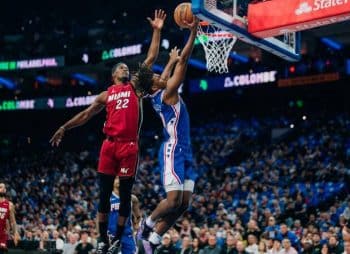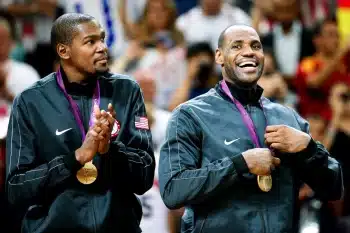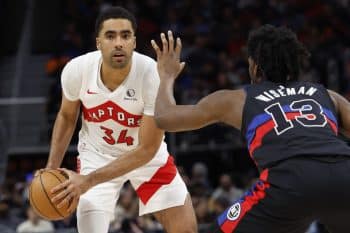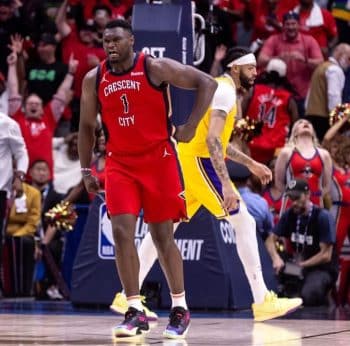NBA
NBA Daily: Could A Junior Basketball League Work?
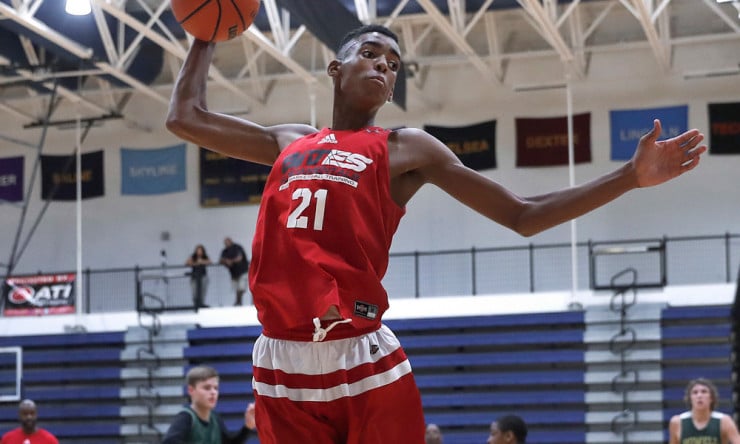
We Got A Logo And Everything
Famed hype man LaVar Ball took to social media yesterday to announce he was building his own junior basketball league that he has dubbed the “Junior Basketball Association” or JBA.
While we’re not going to spend a lot of time on Ball or how he has managed to continue to stay in the press. The idea of a league for players just out of high school but not interested in college is interesting on a couple of fronts.
Before we get too deep into this, there is a strong chance the NBA and the Players Association are going to do away with the much-maligned “One and Done” rule that requires a player to be one year removed from his high school graduating class and turn 19 in the year he is drafted.
The prevailing belief in NBA circles is that likely for the 2020 draft, the NBA will opt for a rule that allows players to come straight from high school into the NBA or stay in college for at least two seasons if not more.
It’s far from decided, but it seems the winds of change are pushing more in that direction than continuing to have the current rule.
So why is Big Baller’s idea interesting if the NBA is going to squash the appeal fairly soon? The NBA isn’t going to take everyone, and Ball’s league could bridge a gap that many have tried to bridge before him.
So, let’s dig into it:
Paying Players
The idea of creating an environment were players who are not interested in the politics of college basketball can be paid to train and develop is not new, virtually ever other year someone surfaces with a dream of building a league to poach some of the top high school talents and bank on them like the NCAA does. The problem is that paying the players isn’t always easy.
Ball’s plan suggests that he’ll pay players up to $10,000 per month. With the average player making a figure closer to $3,000 a month. That all sounds attractive, but how long is the season?
Ball’s own sons recently made news signing a professional deal in Lithuania. However, industry insiders say the deal is basically for $4,000 and what is likely going to be four games, almost no one expects them to be on the roster beyond that stint.
So how long is the JBA season? That will factor into the appeal of any new league significantly. Equally how many games? And what’s the coaching and training staff look like?
Those are all going to factor into a big chunk of overhead on any new start-up team, beyond a payroll that could clock in at $35,000 a month.
As much as people like to talk about the appeal of young guys, can they really generate attendance of 2,000 to 3,000 per game? The G-League isn’t doing that on a regular basis, and they have the sales support of their parent NBA teams.
Equally are the top 10 collegiate prospects going to turn away the likes of the famed college programs such as Kentucky, North Carolina and Duke for a few months in Ballerville for $30,000-$40,000?
If the answer is no, will the next 20 players in any particular high school class draw enough attention to meet payroll? Let alone the other costs of the league.
Arenas Are Not Cheap
Speaking of costs, ever try and rent a gym? How about an arena?
Orlando’s Amway Arena runs roughly $15,000 plus actual staff expenses for things like fundraisers and graduations. A concert, which is what the JBA would likely fall under, would run north of $50,000 per event date. That’s in Central Florida, not a major metro situation like New York or Chicago where competition for large event space is much higher.
The idea that a new startup league is going to play in NBA sized venues is a bit misplaced, especially if it’s happening concurrently with the NBA season. So that means the league is moving to smaller venues, which would cap attendance.
You can also cross off using any venue that has an association with a Division 1 NCAA school, again they are going to have first rights to dates, and they are going to view any league pulling talent away as a competitor.
It’s not going to be impossible to find spaces, but it does mean those spaces may not be the most desirable and they will be limiting on a lot of fronts.
Travel Is A Big Factor
So, the idea is for a 10-team league in places like Los Angeles, Dallas, Brooklyn, and Atlanta. While all of these are major airline destinations, the travel is still a killer. It’s been what’s killed other startup leagues because it’s an area of expense you cannot monetize.
If you host a game, you can at least charge for tickets, sell advertising and sponsorships and, if you are lucky, sell broadcasting rights.
You can’t exactly attach a sponsor to your road trip expenses.
So again, how long is the season? If every team plays each other one time, each team incurs ten travel dates. If the new league travels like the G-League travels, they will fly the day before the game because commercial travel is unpredictable. They would incur a hotel night the night before the game and the day of the game. Then travel to the next stop.
So, let’s say the new league does a deal with a major hotel chain and gets a flat rate for all their nights at something close to the median rate of $130 a night for a Courtyard by Marriott type hotel (which is what the G-League does), the real costs of travel (based on rates today) is about $150 a leg for airfare on an airline like Southwest, plus two nights hotel at $130 per night, plus food. So, lets generously call that $560 per player.
Assume JBA teams travel just like G-League teams, and send three coaches and an executive/GM type and no parents. That’s 12 heads times $560 per road trip or $6.720. Multiple that by ten road games.
By the way, we didn’t account for bus services to and from the airports or the hotels.
Equally, anyone that travels to major cities will tell you, good luck finding travel accommodations at those kinds of prices, especially during peak travel windows. But for the sake of discussion, let’s assume the new league can make great corporate deals with an unproven, untested product.
Let’s also forget that most major NCAA programs travel charter and stay in four and five-star hotels when they travel and that the players coming to the JBA will be open to staying several steps down the ladder to be part of a league that most won’t see play.
Broadcast Rights
Here is where Ball may have an advantage: broadcast rights.
Last year, rapper and media mogul Ice Cube and several business partners launched an upstart 3-on-3 league featuring mostly retired NBA basketball players called the Big3. Not only did Fox Sports go all in on the Big3 in a major way, but they have also renewed for a second season and have made a commitment to carry many games live.
Ball’s family already has a multi-million dollar relationship with Facebook for their own reality television show, which Facebook renewed for a second season. Could that be where Ball’s JBA finds its golden parachute? ESPN is what’s made The Basketball Tournament (TBT) viable.
Could Facebook be the answer to the JBA’s problems? That’s a very real thing.
Where most upstart leagues that have tried to tackle this problem have run into problems is that some media partners have been willing to license their games, but most won’t eat the production costs.
With new broadcast players entering the streaming sports market every year, could the desire for content provide the revenue to make all of this work?
That’s where the incredibly media savvy Ball may have a leg up on others that have tried to fill this gap because he has business relationships in that space already.
Selling The League
Let’s also be realistic about the long-game for any of these leagues. If anyone wants to have a long-term business in this particular space, they are going to need major backing. While media companies may latch on for a rights fee, the real value in something like this is if it is can be sold.
The NBA is taking an increasingly active role in youth level basketball, announcing this month that they will get behind a Jr. NBA Tournament series, much like the Little League World Series. They are investing in NBA branded training academies all over the world to help develop the next generation of basketball players. So, a league like this might be something the NBA looks at partnering with.
If you think back to the beginning days of the NBA minor league, it started with acquiring existing markets that were part of the Continental Basketball Association.
The CBA might not be the best example, though, because they overplayed their hand and ultimately lost out on a major payday. The NBA eventually gobbled up some individual teams on their own after the CBA crumbled, as well. Still, the idea is the same.
If a league like this has success, and really solves the gap, would the NBA or another major entity get involved in a way to give it the resources and support to thrive?
Selling The Players
Something no one involved in these kinds of endeavors talks about is that fact that a league like this could do the same thing international teams do with young players, and that is to sign them, develop them and then sell them off to the NBA or other pro leagues with hefty buyouts.
The current NBA Collective Bargaining Agreement allows NBA teams to pay up to $700,000 towards the buyout of a professional contract for the 2018-19 season. That number increases every year by roughly $25,000.
Dallas Mavericks owner Mark Cuban once speculated that it might be a good business for someone with the capital to gobble up 8 to 10 of the top high school freshman, pay for their development and then bank on two or three of them becoming top ten picks.
Nothing in the NBA would bar a team from buying out a professional contract issued in the United States.
If the JBA league brings in 80 players a season, and 10 of them become top 20 picks, and they can command the full allowable NBA buyout, that’s $7 million a year in buyout money.
Equally, the JBA could do the same internationally, although likely at a smaller value. The G-League has buyouts in their contracts worth between $40,000 and $50,000 for players signed to their league that opt to leave mid-season. That buyout is paid either by the acquiring team or the player himself.
With the emergence of two-way contracts in the NBA, roughly 60 players that would have normally played abroad opted to stay in the NBA. If the trend continues, international teams will need a pipeline to promising talent and a bridge league like the JBA—one that was smart about the players it targeted—could fill that gap too.
While the idea of a bridge league to cover the gap between high school and NBA eligibility has been kicked around a lot over the years, there may be an interesting convergence of timing, media publicity and desire for content that makes this league idea more viable than ones that have come before it.
Regardless of how you feel about LaVar Ball or his antics, he has lived this problem with his two sons. As investment people will tell you, the best business ideas are the ones that solve a real problem.
The challenge for any new league doing this is at any point, the NBA could change their rules and make the problem the league solves obsolete.
As they say, timing is often everything.
Can Ball and the JBA get their league off the ground before the NBA decides to address the issue?
That is one of the biggest questions of them all.
More Twitter: Make sure you are following all of our guys on Twitter to ensure you are getting the very latest from our team: @stevekylerNBA, @MikeAScotto, @LangGreene, @EricPincus, @joelbrigham, @TommyBeer, @MokeHamilton , @JBAancartenba, @Ben_Dowsett, @SpinDavies, @BuddyGrizzard, @JamesB_NBA, @DennisChambers_, and @Ben__Nadeau .
